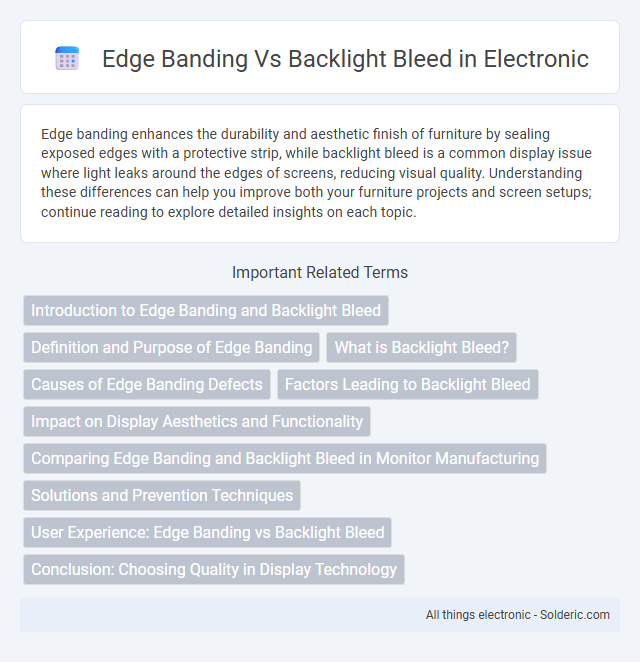Edge banding enhances the durability and aesthetic finish of furniture by sealing exposed edges with a protective strip, while backlight bleed is a common display issue where light leaks around the edges of screens, reducing visual quality. Understanding these differences can help you improve both your furniture projects and screen setups; continue reading to explore detailed insights on each topic.
Comparison Table
| Feature | Edge Banding | Backlight Bleed |
|---|---|---|
| Definition | Manufacturing technique applying a strip to cover exposed edges of panels. | Display issue where excess light leaks around screen edges. |
| Industry | Furniture, cabinetry, woodworking. | Consumer electronics, monitors, TVs. |
| Purpose | Enhance durability and aesthetics of panel edges. | Unintended defect causing visual distraction. |
| Material | Wood veneer, PVC, ABS, melamine strips. | LED or LCD display backlighting components. |
| Impact | Improves finish quality and longevity of furniture surfaces. | Reduces display quality and viewer experience. |
| Correction | Proper application and quality control in production. | Screen replacement, adjustment, or improved panel design. |
Introduction to Edge Banding and Backlight Bleed
Edge banding is a finishing technique applied to the exposed edges of materials like plywood or MDF to enhance durability and aesthetic appeal, preventing moisture damage and improving overall product quality. Backlight bleed refers to the uneven light leakage around the edges of LCD screens, which can affect image quality and viewing experience by causing bright spots or halos on dark backgrounds. Understanding the differences between edge banding and backlight bleed helps you identify the improvements needed in furniture manufacturing versus display technology performance.
Definition and Purpose of Edge Banding
Edge banding is a thin strip of material applied to the exposed edges of wood or composite panels to protect and enhance their appearance. Its primary purpose is to prevent moisture infiltration and provide a smooth, finished look that matches or contrasts with your cabinetry or furniture surfaces. Unlike backlight bleed, which is an issue related to screen manufacturing defects, edge banding focuses on improving durability and aesthetics in woodworking projects.
What is Backlight Bleed?
Backlight bleed occurs when the light from a display's backlight leaks around the edges or corners of the screen, causing uneven brightness and visible glow. It is most noticeable in dark scenes or low-light conditions, affecting LCD monitors and televisions with LED or LCD panels. Edge banding, by contrast, refers to the visible lines or stripes caused by limited color depth, unrelated to the light leakage phenomenon seen in backlight bleed.
Causes of Edge Banding Defects
Edge banding defects primarily arise from improper adhesive application, causing gaps or peeling along the edges of laminated surfaces. Inconsistent pressure during the edge banding process can lead to uneven bonding, resulting in visible seams or bubbles. Your choice of low-quality materials and incorrect temperature settings further contribute to edge banding issues by weakening the durability and appearance of the finished product.
Factors Leading to Backlight Bleed
Backlight bleed occurs when light leaks around the edges of an LCD screen, often due to poor edge banding or uneven panel pressure during manufacturing. Factors leading to backlight bleed include inadequate sealing of the screen's edges, imperfections in the panel assembly, and excessive pressure applied to the LCD layers. Understanding these causes helps you identify and potentially minimize backlight bleed in your display devices.
Impact on Display Aesthetics and Functionality
Edge banding enhances display aesthetics by providing a clean, uniform frame that hides panel edges, improving the overall visual appeal of your monitor or TV. Backlight bleed, however, detracts from display functionality and image quality by causing uneven lighting, which results in distracting bright spots or halos, especially in dark scenes. While edge banding improves the physical appearance and durability of the screen bezel, controlling backlight bleed is crucial for maintaining accurate color representation and immersive viewing experiences.
Comparing Edge Banding and Backlight Bleed in Monitor Manufacturing
Edge banding in monitor manufacturing involves applying a protective strip to the edges of display panels to enhance durability and aesthetics, while backlight bleed refers to unwanted light leakage around the screen edges due to imperfect panel assembly. You should consider that edge banding improves the structural integrity and visual finish of monitors, whereas backlight bleed impacts image quality by causing uneven brightness in dark scenes. Manufacturers prioritize precise edge bonding techniques to minimize backlight bleed and maximize display uniformity.
Solutions and Prevention Techniques
Edge banding enhances furniture durability and aesthetics by sealing raw edges, preventing moisture damage and wear, while backlight bleed solutions involve adjusting monitor settings, applying black adhesive tape, or using screens with better backlight diffusion to minimize light leakage. You can prevent backlight bleed by purchasing high-quality monitors with advanced backlight technology and ensuring proper casing assembly. Regular maintenance and choosing edge banding materials resistant to humidity significantly extend your furniture's lifespan and appearance.
User Experience: Edge Banding vs Backlight Bleed
Edge banding enhances user experience by providing a polished, smooth finish on display edges, preventing discomfort or accidental damage during touch interactions. Backlight bleed negatively impacts user experience by causing uneven brightness and distracting light leaks around screen borders, reducing image quality and visual comfort. Choosing displays with minimal backlight bleed and quality edge banding ensures improved durability and consistent visual performance.
Conclusion: Choosing Quality in Display Technology
Choosing quality in display technology hinges on selecting panels with superior manufacturing and material standards to minimize edge banding and backlight bleed, both of which degrade visual experience. Your ideal display should exhibit uniform brightness and consistent edge finishes, ensuring vivid colors and sharp images without distracting light leaks or uneven seams. Prioritizing these quality factors yields a more immersive and reliable viewing experience, crucial for professional and entertainment use.
Edge Banding vs Backlight Bleed Infographic

 solderic.com
solderic.com